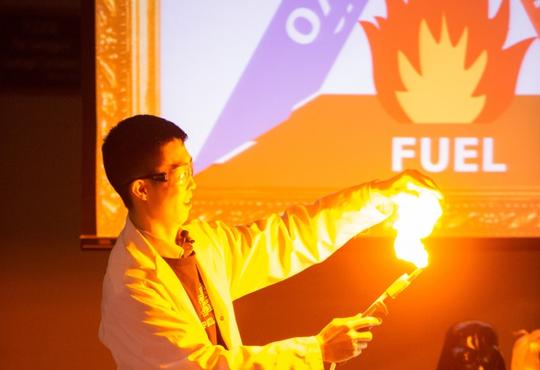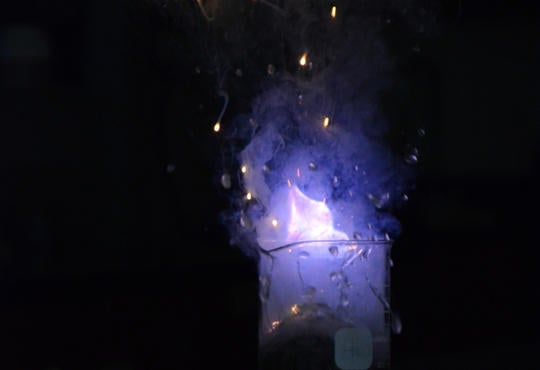|
G. Robert Shelton Texas A&M University–San Antonio San Antonio TX |
Bob Casao Montwood High School El Paso TX |
Diana Mason University Of North Texas Denton TX |
|---|

In the April 2016 issue, the article on "Firsts" highlighted mugs dedicated to two professors who taught at The University of Texas at Austin (UT Austin): Morgan and Lagowski. These are examples of two original signatures that we (Associated Chemistry Teachers of Texas, ACT2) were able to obtain. Five additional mugs presented to our members have original signatures and ties to Texas. Two native sons, Choppin and Curl, and three more who either taught at or visited universities in Texas: Smalley, Kroto and our last mug signed by Oganessian.
The Oganessian mug is the last in the ACT2 signature mug series. Oganessian (born in 1933) is a Russian nuclear physicist and Scientific Director of the Joint Institute for Nuclear Research (JINR), Dubna. He leads a team who made elements with atomic numbers
Z = 113-118, all of which by June 2016 are named by IUPAC. On June 8, 2016, oganesson (Og) became the proposed name for element 118 — see page 6 of this issue. (Only two elements have been named for still-living scientists, oganesson and seaborgium.) Oganessian's lab works closely with the Lawrence Livermore National Laboratory in Livermore, California and is regarded as the world's leader in the search for and discovery of new elements. The last author obtained his signature by traveling to Texas A&M University in College Station in August 2015 when he was spending a year at their cyclotron facility as a Faculty Fellow. Oganessian proposed — and with his colleagues, developed — a method to synthesize extremely heavy nuclei through fusion reactions of calcium-48 nuclei, an extremely rare isotope of calcium (20 protons and 28 neutrons) with nuclei of naturally occurring and synthetic actinide elements that have atomic numbers from 93 to 98.
The element flerovium (Fl), a superheavy element
(Z ≥ 104) with an atomic number 114, was selected for the mug from his 12 discoveries in order to highlight the symbol granted by IUPAC. As many teachers know, Fl is often "provided" by students as the symbol for fluorine. With F and Fl now both being proud members of the periodic table, there is no longer an excuse for that "minor" typo! The decay properties of Fl proved the existence of the “island of stability” for very heavy elements, a theory first proposed in the late 1960s, which predicted noble-gas-like metallic character. Interestingly, Fl is the least reactive element in its group.
Gregory Choppin (1927-2015) was born in Eagle Lake, Texas but spent most of his life in Louisiana. He is known as one of the co-discoverers of mendelevium, atomic number 101, with Ghiorso, Harvey, Thompson and Seaborg. After receiving his Bachelor of Science degree at Loyola University, New Orleans, Louisiana and his doctorate at UT Austin, he became a research professor in 1956 at Florida State University where he continued his research on actinide and lanthanide elements. Only a few atoms of Md have ever been created, and it is the first element that currently cannot be produced in macroscopic quantities through neutron bombardment of lighter elements. He is also sometimes credited with co-discovering einsteinium and fermium.
Texas is the only state of the USA to claim a molecule as one of its designated symbols. Two of the Nobel Laureates who discovered the third allotrope of carbon, buckminsterfullerene (C60) or buckyballs, were professors at Rice University in Houston, Texas. The third recipient was from the United Kingdom. The trio of Richard Smalley, Floyd Robert (Bob) Curl and Sir Harry Kroto, FRS, received a Nobel Prize in 1996 for their 1985 discovery. Their discovery was deemed worthy of a Nobel Prize because it birthed many research and commercial fields in nanotechnology emphasizing this discovery's broader impact.
Smalley (1943-2005) in his Nobel lecture considered his boyhood activities "a wonderful preparation for my later career as an experimentalist working on the frontiers of chemistry and physics." He moved to Houston in 1976 as an assistant professor in the chemistry department at Rice University principally to collaborate with Bob Curl on laser spectroscopy. Kroto arrived at Smalley's lab in 1985 to set up experiments vaporizing graphite with lasers that led to the discovery of buckyballs. Smalley saw nanotechnology as the key to producing solar and other renewable energy sources that could replace fossil fuels.
Curl, born in 1933, in the small town of Alice, Texas is one of two Nobel Laureates who graduated from Thomas Jefferson High School in San Antonio, Texas. (The 2014 Chemistry Nobel Prize winner W. E. Moerner graduated from the same school.) Curl graduated from Rice Institute with a Bachelor of Arts in 1954, obtained his PhD at the University of California, Berkeley, in 1957, and then returned to Rice as a professor in 1958. He was inducted as a Charter Member of the 2000 Class of the Texas Science Hall of Fame by the last author. Professor Emeritus Curl will be the first one to tell you that the discovery of buckyballs would not have been possible without the contribution of graduate assistants, James Heath and Sean O'Brien. Unfortunately, Nobel Prizes are limited to only three contributors.
Kroto was an English organic chemist. He did his undergraduate and graduate work at the University of Sheffield. In 1996, he was knighted for his contributions to chemistry, and later that year he received the Nobel Prize in Chemistry with Smalley and Curl. At age 65, Sir Harry reached the mandatory age of retirement in England and was forced to retire from the University of Sussex, Brighton, UK. In 2004 he was invited to cross the pond (Atlantic Ocean) and became a proud Seminole at the Florida State University. Sir Harry (1939-2016) was an ardent advocate for science education, and he devoted much of his time and energy to promoting careers in science among young people. In 2009 he spearheaded the development of a science education initiative, GEOSET, acronym for the Global Educational Outreach for Science, Engineering and Technology. GEOSET is an ever-growing online cache of recorded teaching modules that are freely downloadable to educators and the public. GEOSET aims to increase knowledge of the sciences by creating a global repository of educational videos and presentations from leading universities and institutions.
We are very grateful to these celebrated scientists who have voluntarily given us the use of their personal signatures for these very special keepsakes. In the next article, we will travel back in time to the wide reach of the United Kingdom and famed scientists who made several early discoveries.







